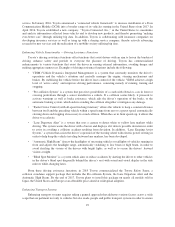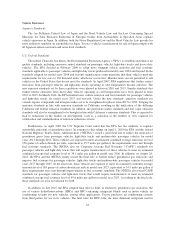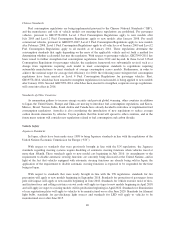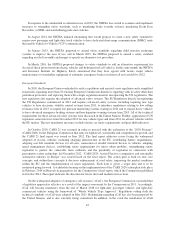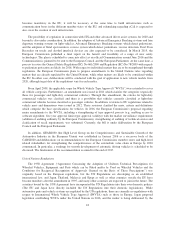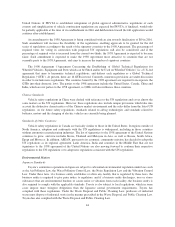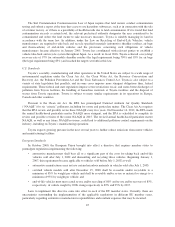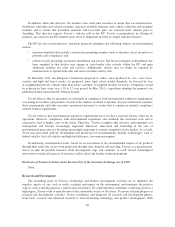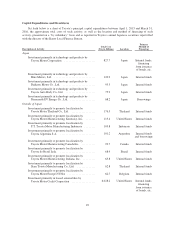Toyota 2015 Annual Report Download - page 44
Download and view the complete annual report
Please find page 44 of the 2015 Toyota annual report below. You can navigate through the pages in the report by either clicking on the pages listed below, or by using the keyword search tool below to find specific information within the annual report.through 2016. These vehicles are required to meet an estimated combined average emissions level of 250 grams
of carbon dioxide per mile, equivalent to 35.5 miles per gallon if the requirements were met through fuel
economy standards. The NHTSA also set CAFE standards for passenger vehicles and light-duty trucks that will
require manufacturers of those vehicles to meet an estimated combined average fuel economy level of 34.1 miles
per gallon in model year 2016. Furthermore, the EPA and the NHTSA joint final rule allows the two agencies
and California standards to act in a unified way, and creates a regulatory framework that makes compliance less
burdensome for the manufacturers. In addition, in December 2011, the EPA and the NHTSA issued a joint
proposed rule to further reduce greenhouse gas emissions and improve fuel economy for passenger vehicles,
light-duty trucks and medium-duty passenger vehicles for model years 2017 through 2025. In the rule, which was
finalized in August 2012, these vehicles are required to meet an estimated combined average emission level of
163 grams of carbon dioxide per mile in model year 2025, equivalent to 54.5 miles per gallon if these
requirements are met through improvements in fuel economy standards. At the same time, the NHTSA also
issued CAFE standards for passenger vehicles and light-duty trucks that would require manufacturers to meet an
estimated combined average fuel economy level of 49.6 miles per gallon in model year 2025. The standards of
fuel economy are stringent, and Toyota strives to meet the fuel economy standards by further developing fuel-
efficient technology, alternative fuel technology and other advanced technology.
In addition, the Energy Tax Act of 1978 imposes a “gas guzzler” tax on automobiles with a fuel economy
rating below specified levels.
European Standards
In December 2008, the European Parliament approved a new regulation that establishes an average emission
standard of 130 grams of carbon dioxide per kilometer by 2012 for passenger vehicles sold in member states,
made effective in June 2009. The regulation has been phased in gradually, initially requiring 65% of new cars to
comply with the new standards in 2012 and increasing to 100% of new cars in 2015. As a result of the new
regulations, different targets will apply to each manufacturer, based on their respective fleets of vehicles and
weight. Penalties will apply to those manufacturers who fail to meet their targets from 2012, in amounts
corresponding to the degree of shortfall. Manufacturers failing to meet their targets between 2012 and 2018 will
incur penalties of between €5 and €95 per each gram of carbon dioxide per kilometer shortfall for each
non-compliant vehicle, and such penalties will rise to €95 in 2019 and beyond. Furthermore, in June 2011, a new
carbon dioxide emission standard applicable to light commercial vehicles entered into force establishing an
average emissions target of 175 grams of carbon dioxide per kilometer. This regulation has the same basic
regulatory framework as passenger vehicles, raising the compliance rate from 70% in 2014 to 100% in 2017.
Furthermore, in February 2014, the European Parliament and Council adopted a regulation to reduce the
average carbon dioxide emissions target for light commercial vehicles to 147 grams per kilometer beginning in
2020. In March 2014, the European Parliament and Council adopted a regulation to reduce the average carbon
dioxide emissions target for passenger vehicles to 95 grams per kilometer beginning in 2021. 95% of each
manufacturer’s new cars must comply with this new standard by 2020. The relevant legislation requested the
European Commission to conduct a review by 2015 and, if appropriate, propose new targets for the period
beyond 2020, including possibly setting a 2025 target.
An increasing number of EU member states are introducing vehicle tax laws based on carbon dioxide
emission levels pursuant to the directive issued by the European Commission in 2005. This trend is expected to
continue in accordance with the recent increases in environmental awareness.
An EU directive on motor vehicle air conditioning units requires manufacturers to replace currently used
refrigerants with refrigerants having a lower global warming impact for all newly registered vehicles starting in
January 2017.
39


